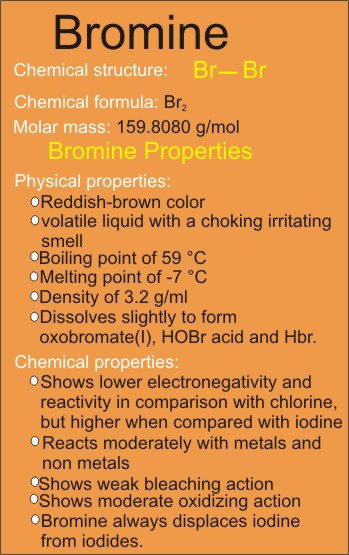|
Home
Bromine: Hazards, Properties, Uses, Formula
What is Bromine? Bromine is a reddish-brown volatile liquid with a choking, irritating smell. It
is identified with the symbol Br and atomic number 35. Bromine is used for
different purposes. It is used in the agriculture sector, the industries, and
even in the laboratories. However, some of its earlier uses are no longer
encouraged due to its effect to the environment.
Bromine is toxic and this article will guide you on how best to handle and avoid
the hazards associated with the chemical.
 Bromine Formula Bromine Formula
The chemical formula of bromine is Br2. It shows two atoms of bromine in a
molecule.
Bromine Properties
Physical Properties
atomic number: 35
Density (g/cm3): 3.2
Molar mass: 159.8080 g/mol
Melting point (oC): -7
Boiling point (oC): 59
Solubility in water:
It dissolves slightly to form oxobromate(I), HOBr acid and HBr
Chemical Properties
Electronegativity and reactivity in comparison with other halides: It shows lower electronegativity
and reactivity in comparison with chlorine, but higher when compared with iodine.
Bromine can be made to react directly with hydrogen only by heating or in the presence of a catalyst such as
platinum.
It reacts moderately with metals and non metals.
It shows weak bleaching action.
Its oxidizing action is moderate.
Bromine reacts with dilute alkalis to form bromate(I) and bromides, while with concentrated
alkalis, it forms bromate(V) and bromides.
Bromine always displaces iodine from iodides.
Compounds of BromineSilver Bromide: Silver bromide is a pale-yellow solid, which is insoluble
in water and in dilute HNO3. It is sparingly soluble in ammonia
solution. In the presence of light, it is reduced to silver.
Hydrogen Bromide: This is a colorless gas, which is soluble in water to
form an acidic, constant boiling mixture. The gas is denser than air.
Oxides of Bromine: No stable oxide of bromine is formed.
Compounds of bromine show the most photoelectric activity compared to compounds
of chlorine and iodine. They also show higher thermal stability than compounds
of iodine but less than those of chlorine.Common Bromine HazardsBromine is dangerous to health if one is exposed it. This chemical has the
ability to destroy the human tissue whether as liquid or gas.
The vapor causes irritation and pain when it enters the eye and throat. Inhaling
bromine is highly toxic to the health.
The liver, lungs, and the entire respiratory system are badly affected.
This chemical also causes harm to the environment when it is used for pest
controls. It literally harms animal life and plant life apart from the pest you
intend to control.
Bromine Safety Handling Procedures
- To avoid the hazards associated with bromine when working with it, here are
safety precautions to apply:
Before you start working with this chemical, protect your body with the proper
kit that is able to keep the chemicals off.
- Your eyes should be protected with goggles that can shield them from
chemicals.
- Your hands should be protected with chemical proof gloves.
- Avoid eating or drinking anything while working with bromine.
Bromine Safety Storage ProcedureTo safely store bromine and reduce or eliminate its hazardous impact on the
environment, here are tips to apply:
- The appropriate place to store bromine is a cool and dry environment far away
from heat, fire, and any combustible item.
- When storing bromine in containers, always make sure you place a label for
identification purpose to be able to differentiate bromine from other items.
- Glass or ceramic containers are appropriate for storing bromine.
Bromine Safety Disposal Procedures Bromine is a very toxic chemical, disposing it in the right way is important.
You can apply the following disposal procedure in order to ensure safety.
- Since disposing bromine is a dangerous practice, it is normally recommended
for you to contact a professional that specializes in disposing chemicals.
- Before taking it to a facility for disposal, you can choose to neutralize its
toxicity first.
- Always follow the standards approved by the authorities.
How to Handle Exposures to Bromine Make use of first aid procedure if you get exposed to bromine. The procedure
will help you reduce or stop the chemical’s damages.
Now, here are tips to apply when exposed to bromine:
- Skin exposure: When bromine touches the skin, make use of enough clean water
to rinse the chemical off your skin. Remove your clothes if they are affected
too.
- Inhalation: Inhaling bromine is very deadly. If inhaled, the victim should be
moved to an open space that has enough fresh air. After this practice, call for
medical attention promptly.
- Ingestion: Ingestion is another thing you should guide against. Whenever
bromine is swallowed, the victim should not be forced to vomit. The mouth should
be rinsed with water and then call for medical attention promptly.
- Fire accident: Sometimes, bromine causes fire accident if it is stored close
to heat, fire or combustible items. You can use extinguishers to put out the
fire. Making use of water jet is a wrong decision, avoid it totally.
Bromine Preparation Naturally, bromine is derived from the earth’s crust and is also found in
seawater.
The industrial method for producing bromine is by reacting chlorine together
with brine ions. This method is usually quick.
Bromine UsesPresently, bromine is mostly used for purification, in the place of chlorine. It
is also used for treating swimming pools as a purifying agent.
It is also used as one of the major ingredients for producing dyes, plastics,
rubber, etc.
|